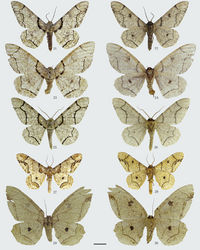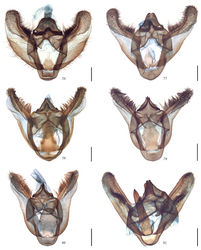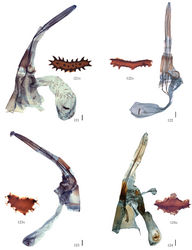Biston bengaliaria
| Notice: | This page is derived from the original publication listed below, whose author(s) should always be credited. Further contributors may edit and improve the content of this page and, consequently, need to be credited as well (see page history). Any assessment of factual correctness requires a careful review of the original article as well as of subsequent contributions.
If you are uncertain whether your planned contribution is correct or not, we suggest that you use the associated discussion page instead of editing the page directly. This page should be cited as follows (rationale):
Citation formats to copy and paste
BibTeX: @article{Jiang2011ZooKeys139, RIS/ Endnote: TY - JOUR Wikipedia/ Citizendium: <ref name="Jiang2011ZooKeys139">{{Citation See also the citation download page at the journal. |
Ordo: Lepidoptera
Familia: Geometridae
Genus: Biston
Name
Biston bengaliaria (Guenée, 1858) – Wikispecies link – Pensoft Profile
- Amphidasis bengaliaria Guenée, 1858[1], in Boisduval & Guenée, Hist. nat. Insectes (Spec. gén. Lépid.), 9: 210; ibidem (1858) Atlas; pl. 4, fig. 2. Syntypes 3♂, 1♀, Bengal; India (central). (BMNH)
- Blepharoctenia bengaliaria : Warren, 1894[2], Novit. zool., 1: 428.
- Biston (Cusiala) bengaliaria : Hampson, 1895[3], Fauna Br. India (Moths), 3: 247.
- Biston bengaliaria : Yazaki, 1992[4], in Haruta, Tinea, 13 (Suppl. 2): 33.
Diagnosis
The external characters of this species are close to those of Biston contectaria, but it can be distinguished from that species by the following differences: the wings are pale yellow but white in Biston contectaria; the forewing postmedial line is much narrower and protruding outwards between CuA2 and 1A + 2A, while in Biston contectaria, it is broader and without such a protrusion; the discal spot on the hindwing upperside is large, round, black, while in Biston contectaria it is almost absent; the discal spots on the underside of both wings are larger and heavier. The male genitalia are close to those of Biston suppressaria, but it can be distinguished by the square apex of the juxta, the shorter median process of the gnathos and the presence of a cornutus which is a short spinous patch. The female genitalia are similar to those of Biston suppressaria. But it differs in that the corpus bursae is coiled anteriorly; the signum is longer and narrower; the ostium bursae is more strongly sclerotized.
Material examineds
CHINA, Yunnan (IZCAS): Yuanjiang, 500 m, 12.V.1957, coll. Liang Qiuzhen, 1♀; Cangyuan, 750 m, 22.V.1980, coll. Song Shimei, 1♂; Xishuangbanna, Menglun, 27.V.1964, coll. Zhang Baolin, 1♂; Xishuangbanna, Bubang, 700 m, 14.IX.1993, coll. Cheng Xinyue, 3♂. Tibet (IZCAS): Mêdog, Beibung, 700–800 m, 11.VI.1983, coll. Lin Zai, 2♂; Mêdog, Yarang, 902–1091 m, 14–23.VIII.2006, coll. Lang Songyun, 6♂. More material from several parts of Yunnan in coll. ZFMK.
Distribution
China (Yunnan, Tibet), India, Bengal, Thailand.
Taxon Treatment
- Jiang, N; Xue, D; Han, H; 2011: A review of Biston Leach, 1815 (Lepidoptera, Geometridae, Ennominae) from China, with description of one new species ZooKeys, 139: 45-96. doi
Other References
- ↑ Guenée A (1858) Uranides et Phalénites 1. In: Boisduval JBAD, Guenée A (Eds) Histoire naturelle des Insectes (Species général des Lépidoptères) 9: i–lvi, 1–514; 10: 1–584; Atlas; pls. 1–22.
- ↑ Warren W (1894) New genera and species of Geometridae. Novitates Zoologicae 1: 366-466.
- ↑ Hampson G (1895) The Fauna of British India including Ceylon and Burma (Moths). Vol. 3, Taylor and Francis, London, xxviii+546 pp.
- ↑ Yazaki K (1992) Geometridae. In: Haruta T (Ed). Moths of Nepal, part 1. Tinea 13 (Suppl. 2): 5-46.
Images
|



